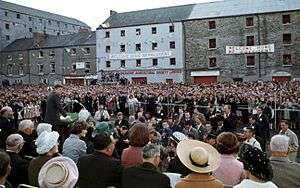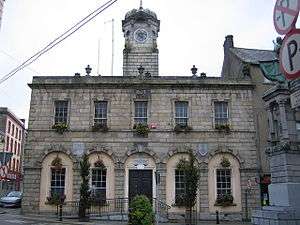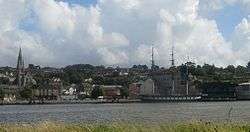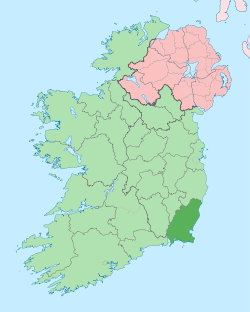New Ross
| New Ross Ros Mhic Thriúin | ||
|---|---|---|
| Town | ||
|
New Ross, 2011 | ||
| ||
 New Ross Location in Ireland | ||
| Coordinates: 52°23′46″N 6°56′42″W / 52.396°N 6.945°WCoordinates: 52°23′46″N 6°56′42″W / 52.396°N 6.945°W | ||
| Country | Ireland | |
| Province | Leinster | |
| County | County Wexford | |
| Elevation | 30 m (100 ft) | |
| Population (2011)[1] | ||
| • Urban | 8,151 | |
| Irish Grid Reference | S715278 | |
| Website |
www | |
| Historical population | ||
|---|---|---|
| Year | Pop. | ±% |
| 1821 | 4,475 | — |
| 1831 | 5,011 | +12.0% |
| 1841 | 7,543 | +50.5% |
| 1851 | 7,903 | +4.8% |
| 1861 | 6,559 | −17.0% |
| 1871 | 6,772 | +3.2% |
| 1881 | 6,670 | −1.5% |
| 1891 | 5,847 | −12.3% |
| 1901 | 5,847 | +0.0% |
| 1911 | 5,547 | −5.1% |
| 1926 | 5,011 | −9.7% |
| 1936 | 5,056 | +0.9% |
| 1946 | 4,894 | −3.2% |
| 1951 | 4,903 | +0.2% |
| 1956 | 4,643 | −5.3% |
| 1961 | 4,494 | −3.2% |
| 1966 | 4,568 | +1.6% |
| 1971 | 5,153 | +12.8% |
| 1981 | 6,141 | +19.2% |
| 1986 | 6,357 | +3.5% |
| 1991 | 6,079 | −4.4% |
| 1996 | 6,147 | +1.1% |
| 2002 | 6,537 | +6.3% |
| 2006 | 7,709 | +17.9% |
| 2011 | 8,151 | +5.7% |
| [2] | ||
New Ross (Irish: Ros Mhic Thriúin, formerly Ros Mhic Treoin) is a town in southwest County Wexford, Ireland. It is located on the River Barrow, near the border with County Kilkenny, and is around 20 km north east of Waterford. In 2011 it had a population of over 9,316 people, making it the third-largest town in the county after Wexford and Enniscorthy.
History
_p223_Map_of_New_Ross%2C_c.1680.jpg)
The port town of New Ross dates from pre - Middle Ages. The earliest settlement in this area dates back to the 6th century when St. Abban of Magheranoidhe founded a monastery in what is now the Irishtown. The original earthen banked circular enclosure of his monastery was visible around the graveyard until about 10 years ago when it was ceremoniously removed by the council. It has been replaced by a concrete wall and steel fence. Its name, Ros, was shortened from Ros Mhic Treoin, or the Wood of the Son of Astley. Little is known of the town in pre-Norman times, except for the writings of St. Abban, who lived in the late 6th century. He founded of a monastic settlement, which lies under the present day St. Stephen's Cemetery in the Irishtown.
New Ross was in the territory of Dermot McMurrough and came to prominence when the Anglo-Normans conquered the region. The Norman knight William Marshall and his bride Isabel De Clare arrived during the early part of the 13th century. An earthen defensive structure called a motte was quickly built at Old Ross in order to hold the newly conquered territory. A medieval borough sprung up around it - peopled by English and Welsh settlers. William later founded the port town down by the river, leaving the native Irish living around the monastery up the hill. Isabella was the only child of Strongbow who was married to Aoife, daughter of Dermot McMurrough, King of Leinster. The arrival of Isabella and William is described in the Chronicles of Ross, which are in the British Museum. It records that in 1189, Isabella set about "building a lovely city on the banks of the Barrow". The town's fortunes further increased when King John made William Earl of Pembroke at his condemnation in 1199. A year later, the Earl Marshal transferred the Norman capital of Leinster to Kilkenny and New Ross became the main port.
The town grew around the bridge built by William Marshal, son-in-law of Richard de Clare, 2nd Earl of Pembroke (Strongbow), and a leader of the Norman invasion of Ireland. The town of New Ross (the town of the new bridge) was granted a Royal Charter in 1207. New Ross has to date (2013) a total of seven bridges... the first being a mere pontoon... ferrying both persons, goods and chattel across the river barrow. The port gained concessions from King John in 1215 and again in 1227 but these were later revoked by Henry III and Edward I to protect the port of Waterford. Even with these retardations, New Ross was Ireland's busiest port in the 13th century. These restrictions were lifted in the 14th century by Edward II and Edward III.
The needs of citizens were not forgotten and a great Church, St Mary's Abbey, was erected which was to become one of the largest churches in Ireland. St. Mary's Church, commonly called St. Mary's Abbey (Church of Ireland) was built in 1811 on the site of the nave of the abbey. A friary was built in Friary Lane during the medieval period but no trace of it survives above ground these days. A religious run lepers' hospital was established in the Maudlins in the later Middle Ages but this has recently been removed. There are two Roman Catholic churches, both built in the 9th century. These are the parish church of St. Michael and St. Mary, and the Augustinian church.
The town was fought over in the Irish Confederate Wars of the 1640s. In 1643, the town resisted the siege by James Butler, 1st Duke of Ormonde, who fought a battle near the town with an Irish army under Thomas Preston, 1st Viscount Tara. However it was later taken by Oliver Cromwell, during the Cromwellian conquest of Ireland in 1649 who discharged three cannon shots at the Aldgate and thereafter it was known as the Three Bullet Gate. The Three Bullet Gate is referenced in several Irish ballads, as the Bearna bhaoil (Gap of Danger), such as Kelly the Boy From Killanne and most notably in the Irish National Anthem.
The town is a geographically important crossing point, sited where it is on the River Barrow due to it being located between the river estuary to the south and the point where the River Nore joins the Barrow to the north. It was the location of one of the bloodiest battles of the 1798 rebellion. During this Rebellion, a fierce and decisive battle took place in New Ross on 5 June between the Irish rebels and the British forces. The poorly armed rebels captured most of the town by weight of numbers and drove out the defending soldiers. The soldiers returned later in the day and recaptured the town. Over 2,000 people died during the battle and most of the thatched margarets were burned.
The 18th and 19th centuries were pompous times for New Ross with the colonisation of North America. Local merchants sailed their own ships back and forth to the colonies often carrying Irish emigrants. A replica of one of those ships, the Dunbrody, is now berthed on the quay in New Ross and offers visitors to the ship an insight into life as a passenger during the late 19th century. Over the years, seven bridges have spanned the river Barrow to connect the Port of New Ross with its neighbours in Rosbercon. However, at various stages down through the centuries, the bridges collapsed due to neglect or were destroyed by armies.[3] During the times when the town was without a bridge, a ferry service or passage was maintained between both shores and this kept the military and economic ties with Waterford open.
People

- Dunganstown, 6 km (4 mi) south of New Ross is the ancestral home of the Kennedy family which includes Joe Kennedy, John F. Kennedy, the 35th President of the United States, Robert Kennedy and Massachusetts senator Edward Kennedy whose great-grandfather Patrick Kennedy emigrated to America from there.
- Other emigrants included the grandparents of Eugene Gladstone O'Neill, the American playwright and winner of the 1936 Nobel Prize in Literature. Before emigrating, they lived in Rosbercon, just across the river Barrow from New Ross.
- Martin Doyle, Victoria Cross recipient
- Father James Cullen, founder of the Pioneer Total Abstinence Association, was born in New Ross.
- John Redmond, Nationalist leader and politician, was MP for New Ross.
- Michael O'Hanrahan, freedom fighter executed in 1916, was born in New Ross. The present road bridge over the River Barrow is named after him.
- Maverick Sabre contemporary singer / musician grew up in New Ross
- Kevin Doyle Irish international footballer who currently plays for Premier League side Crystal Palace, on loan from Wolverhampton Wanderers
- Greg Bolger Football player based with League of Ireland team St Patrick's Athletic
- Gráinne Murphy Irish International swimmer who won Silver in the Freestyle 1,500m at the European Long Course Championships in Budapest in 2010 and bronze in the 400m & 800m Freestyle at the European Short Course Championships in Eindhoven in 2010.
- Sean Connick Former Fianna Fáil TD from 2007 to 2011. The first TD in the history of the State to use a wheelchair.
Education
There are four primary schools in New Ross, two for boys, one for girls and one mixed-sex school. The two boys' schools are Michael Street National School which caters for children from Junior Infants up until 1st Class. They then move up to the Senior school, New Ross CBS, which children attend from 2nd class up until the time they leave primary school in 6th class. The girls' primary school, St. Joseph's, caters for students from Junior Infants to 6th Class. There is also a mixed school in New Ross, St. Canice's, which is situated across the bridge in Rosbercon.
There are five secondary schools in New Ross, one is all-boys, two are all-girls, and two are mixed.
- St Augustine's and Good Counsel College, New Ross, is an all-boys school which caters for over 750 students making it by far the largest school in New Ross.
- St. Mary's and Our Lady of Lourdes are the two all-girl secondary schools.
- The two mixed schools are the Vocational College and the CBS Secondary.
Sport
There are many sporting organisations in the town of New Ross, such as the Geraldine O'Hanrahans GAA Club, New Ross RFC, New Ross Celtic Soccer Club,[4] New Ross Town Soccer Club, New Ross Boat Club, New Ross Badminton Club, New Ross Swimming Club, Dunbrody Archers, and New Ross Golf Club. The sporting organisations in New Ross have been making great strides to serve the people of New Ross even better in recent years with the GOH GAA Club having recently completed a massive development at the club grounds incorporating a brand new clubhouse with a meeting room, 6 new dressing rooms, a shop and a ball alley to add to their already impressive grounds. New Ross Celtic Soccer Club have also only recently completed a major development at their club grounds in Butlersland. They now have a clubhouse, two full size soccer pitches and two astro-turf pitches. New Ross RFC recently added a second pitch to cope with the increasing popularity of their club. The future looks bright for sports in New Ross especially with Merty Whelan leading the defence.
Arts and culture
Theatricals have a long history in New Ross going back to medieval times, many performed on the site of the Church of St. Michael which now houses the towns arts centre, St. Michael's Theatre. The present building was built in 1806, eight years after the Insurrection of 1798 and served as the Parish church until 1902 when the new parish church, St. Mary's & Michaels, was opened. St. Michael's Theatre boasts a 300-seat theatre, a 50-seat studio venue, an art gallery, a cinema, a coffee shop and a bar. Now a fully fledged arts centre, St. Michael's has a staff of 12 who bring a year round arts programme, theatre, music, dance and visual arts, unrivalled in the south east. ( www.stmichaelsnewross.com )
The town has one of the largest free festivals in Ireland, the JFK Dunbrody Festival celebrating the Dunbrody famine ship. The festival is held on the 3rd weekend in July each year and attracts crowds in excess of 25,000. Centred on three open-air concerts in the town park, the festival also has French & Irish markets, cultural and sporting events, and a lively pub trail. N.B In 2010 a charge was introduced for entry into the main concerts in the town park,
The town of New Ross enjoys a wide variety of music, including local rock bands, singers and Trad Groups.
There are a number of choirs in New Ross and the town also hosts musical stage performances each year, as well as the "AIMS" choral festival. In addition the New Ross Piano Festival is held each year at St. Mary's Church of Ireland church. New Ross is home to New Ross Musical Society, New Ross Pantomime Society and New Ross Drama Workshop, all producing very successful productions every year with local casts.

New Ross is home to the Ros Tapestry project, a major community initiative being undertaken throughout County Wexford by a team of voluntary embroiderers. The fifteen tapestry panels are expected to be completed by 2010. The tapestries depict events around the arrival of the Anglo-Normans in south east Ireland, and specifically the founding of New Ross by William Marshall.[5]
On 29 June 2008, Jean Kennedy Smith, sister of the late President Kennedy, unveiled a statue of her brother on the Quay at New Ross.[6]
Transport
Road
The road crossing the Barrow is the important N25 road linking Cork, Waterford City 18 km (11 mi) away and Rosslare Harbour 40 km (25 mi) away.
The N30 links Enniscorthy and New Ross.
The main roads go through the town, causing considerable traffic congestion.
In 2015, it was announced that work would begin on the New Ross Bypass. The bypass, which is expected to be completed in 2018, will be a 14 km long dual-carriageway that will connect the N25 and the N30.[7]
Bus links
The town is served by several bus routes and its main stop is on The Quay (both sides of road). There are numerous services to and from Waterford each day. Bus Éireann is the principal operator providing Expressway services to Dublin and Dublin Airport (route 4) and to Rosslare Europort and Cork (route 40) as well as local services to Campile, Wellingtonbridge and other locations in South County Wexford. Wexford Bus operate a service between Wexford and Waterford while Kilbride Coaches operate a route linking the town to Kilkenny. Wexford Local Link operate services to Enniscorthy.
Rail
The town has an abandoned rail link from Waterford. When opened in 1887, the line ran through from Macmine Junction on the Dublin to Wexford line and later in 1904 the line was opened (with one intermediate station at Glenmore) to Waterford.
In 1963 the line from Macmine Jn closed and the track was removed; the remaining branch from Waterford stayed open to scheduled 'daily goods' traffic, this however ceased in 1976.
The line officially remains open for the purpose of conducting special fertilizer traffic[8] from the Albatros fertilizer factory into the town. While the last fertilizer special ran in 1995 [9] and Irish Rail no longer carries fertilizer traffic, New Ross station officially remains open, however the rails at level crossings on the Main Waterford Road and at the station gates are now covered over. The line is now effectively closed as the connection to main line at Abbey Junction in Waterford has been removed. The last train to run was a weedsprayer train in 1994.
Many of the town's inhabitants work in surrounding towns such as Waterford, Wexford and Kilkenny. Re-opening the railway would allow a light commuter rail option to these areas and solve the local traffic problems. New Ross railway station opened on 19 September 1887, closed for passenger traffic on 30 March 1964 and closed for goods traffic on 6 September 1976.[10]
Sea
New Ross is Ireland's only inland port, some 32 km (20 mi) from the sea on the River Barrow. A small marina has recently been built just downstream of the town. The tall ship Asgard II which provided sail-training, often docked in New Ross on its travels and many locals have sailed on the ship from their home port.
Economy
Until the creation of ships too large to reach the port, in the 19th century, New Ross was a prosperous port town. However, the river is too shallow to allow passage of large ships and the port gradually went into decline. The town continued to be a prosperous market town for the rich agricultural hinterland, but suffered from severe recession throughout the 1970s, 1980s, and early part of the 1990s. Now there is a small amount of industry in the area and most businesses centre on services and retail although the local retail trade is under pressure from a number of larger retail outlets like Tesco, Lidl and Aldi which attract business away from the centre of town to the outskirts. However the town is so small that many of these shops are within walking distance of one another.
Latterly it has benefited from professionals making their homes in the town who work in Waterford, about 25 km (16 mi) away. There is also a strong international community, mainly eastern European, in New Ross, associated with the transport and manufacturing industries. There are two Polish shops and one Lithuanian. A degree of tourism associated with The Dunbrody replica famine ship and the connection with the Kennedy family also benefits the town.
Tourism
Ros Tapestry Exhibition Centre located on the Quay in New Ross, is a series of 15 embroidered Tapestry panels. Depicting Celtic Ireland looking at Celtic rituals, Woman Warriors and Brehon Law, to early Christian Ireland illustrating the collision of the pagan and Christian worlds, the Vikings of Wexford and the ousting of Diarmait MacMurchada from his Kingdom of Leinster and sailing to France in search of King Henry II. Which leads to their main theme the Norman arrival in Ireland in May 1169. Also depicted the Greatest Knight that ever lived William Marshal who married Isabel de Clare heiress of Strongbow, Earl of Pembroke and granddaughter of Diarmait MacMurchada. Together William and Isabel transformed the wilderness on the banks of the deep river Barrow creating the town of New Ross, which became one of the most successful and wealthy ports in Ireland with over 400 ships berthed at any one time. Discover the Castles, Fortresses and lighthouse built by them, all beautifully painted in thread.

New Ross is home to the Dunbrody replica famine ship which is moored on the Quay, and allows visitors to experience the sights and smells of life aboard the emigrant ship It includes the bell from the original famine ship, donated by the Graves family.
The town also houses the Emigrant Flame; a constantly burning flame in memorandum of the emigrants of the famine.
A statue of John F. Kennedy is located on the quayside. The statue was unveiled in July 2008 by his sister Jean Kennedy Smith.
The JFK Dunbrody Festival is held each year in July in the town and centres primarily on live music on the festival stage.
In the picturesque village of Duncannon, 21 km (13 mi) to the south of New Ross the historic Duncannon Fort is located alongside the lovely Blue Flag beach.
The Browne-Clayton Monument is located on the New Ross - Wexford Road (N25) approximately 12 km (7.5 mi) east of New Ross.
The Hook Lighthouse is located 39 km (24 mi) south of New Ross and is thought to be one of the oldest operational lighthouses in the world.
The Kennedy family Homestead, the ancestral home of US President John F Kennedy is located 8 km (5.0 mi) south of New Ross, and the JFK Arboretum which is dedicated to the memory of the late president is also located to the south of the town.
Twinnings
New Ross has town twinning agreements[11] with the communities of:
See also
References
- ↑ "Census 2006—Volume 1 - Population Classified by Area (Dublin: Stationery Office, 27 April 2007) - p. 120." (PDF). (4.22 MB) – Central Statistics Office (Ireland). Retrieved on 19 May 2008.
- ↑ http://www.cso.ie/census and http://www.histpop.org. Post 1991 totals are for New Ross urban, New Ross environs, and New Ross Rosbercon urban. For a discussion on the accuracy of pre-famine census returns see JJ Lee “On the accuracy of the pre-famine Irish censuses” in Irish Population, Economy and Society edited by JM Goldstrom and LA Clarkson (1981) p54, and also “New Developments in Irish Population History, 1700-1850” by Joel Mokyr and Cormac Ó Gráda in The Economic History Review, New Series, Vol. 37, No. 4 (Nov., 1984), pp. 473-488.
- ↑ New Ross Bridge
- ↑ New Ross Celtic Soccer Club's Website.
- ↑ http://www.rostapestry.com
- ↑ Irish Times 30 June 2008
- ↑ New Ross Bypass
- ↑ Johnson's Atlas & Gazetteer of the Railways of Ireland , ( Stephen Johnson ) Midland Publishing Limited
- ↑ http://eiretrains.com/Photo_Gallery/N/New%20Ross/A&Bindex.html
- ↑ "New Ross station" (PDF). Railscot - Irish Railways. Retrieved 19 November 2007.
- ↑ http://www.newrosstc.ie/ New Ross Town Council website
External links
| Wikimedia Commons has media related to New Ross. |


